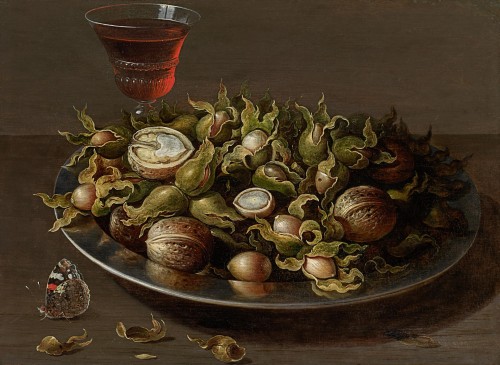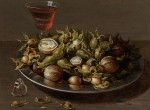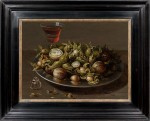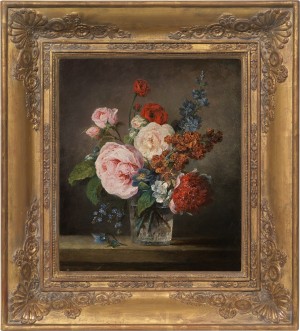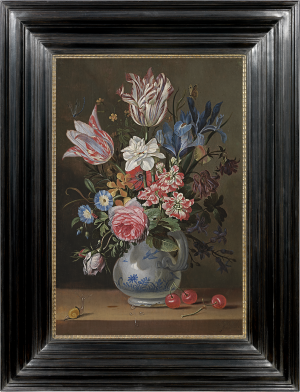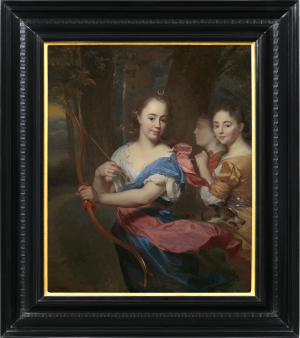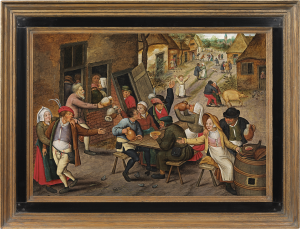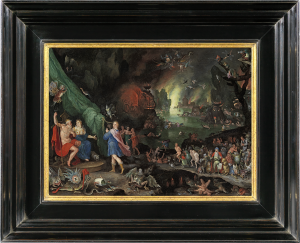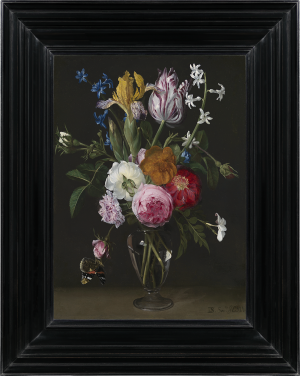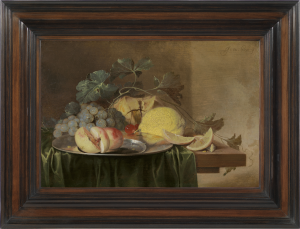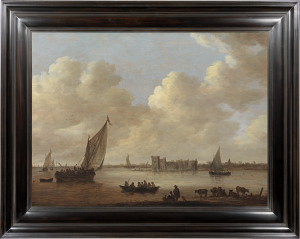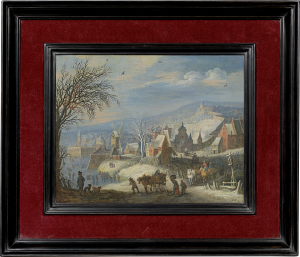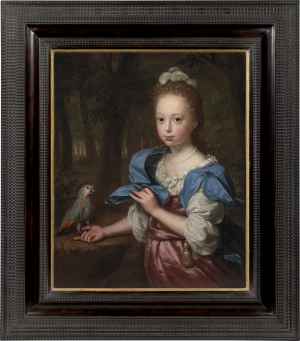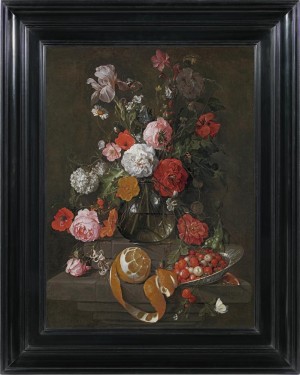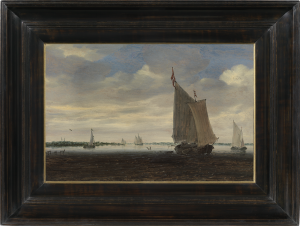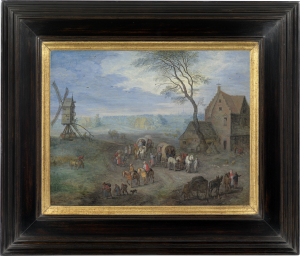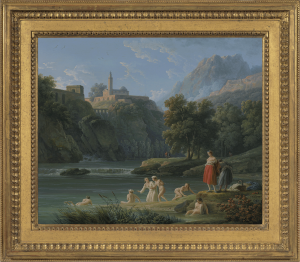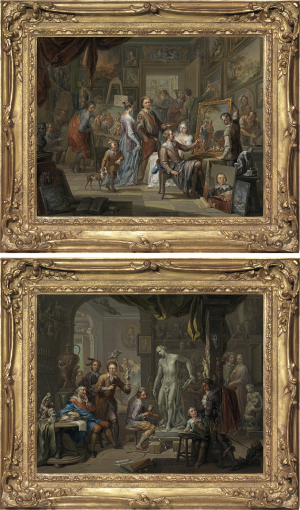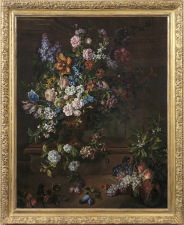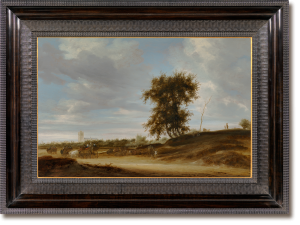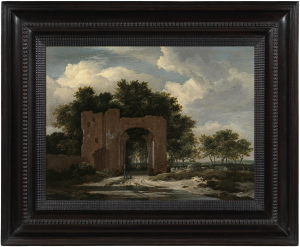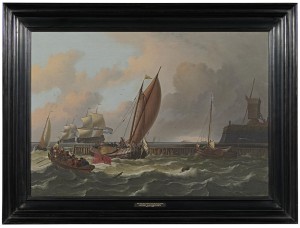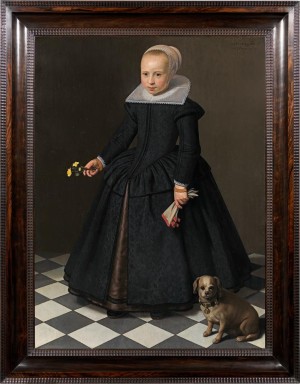Osias Beert The Elder
Still life of a pewter plate of hazelnuts and walnuts, a facon-de-Venise glass of red wine and a Red Admiral butterfly (Vanessa atalanta) on a table top
Oil on panel: 9.3 x 12.5 (in) / 23.5 x 31.8 (cm)
This artwork is for sale.
Please contact us on: +44 (0)20 7493 3939.
Email us
OSIAS BEERT THE ELDER
Kortrijk c.1580 - 1624 Antwerp
Ref: CC 105
Still life of a pewter plate of hazelnuts and walnuts, a façon-de-Venise glass of red wine and a Red Admiral butterfly (Vanessa atalanta) on a table top
Oil on panel: 9 ¼ x 12 ½ in / 23.5 x 31.8 cm
Frame size: 13 ½ x 17 in / 34.3 x 43.2 cm
Painted circa 1610
Provenance:
Private collection, South America
Literature on Osias Beert and Antwerp still life:
C. Benedict, « Un peintre oublié des nature mortes – Osias Beert », L’amour de l’Art, 19 (1938), pp. 307-314.
E. Greindl, Les peintres Flamands de Nature Morte au XVIIe Sièlce, Sterrebeek 1983, pp. 22-36, 181-190 and 335-337.
M.-L. Hairs, The Flemish Flower Painters in the XVIIth Century, Brussels 1985, pp. 335-346 and 456-457.
S. Segal, A Prosperous Past – The Sumptuous Still Life in the Netherlands, The Hague 1988, pp. 66-68.
P.H. Decoteau, Clara Peeters, 1594-ca.1640 and the Development of Still-life Painting in Northern Europe, Lingen 1992.
Q. Buvelot, Slow Food: Dutch and Flemish Meal Still Lifes, 1600-1640, Zwolle 2017.
S. Segal & K. Alen, Dutch and Flemish Flower Pieces: Paintings, Drawings and Prints up to the Nineteenth Century, 2 vols, Leiden 2020, vol. 1, pp. 239-242.
K. Alen, Osias Beert. Pioneer of the Antwerp Laid Table and Flower Still Life, forthcoming
Around 1600 the still life as an independent genre emerged in The Netherlands. In Antwerp Osias Beert the Elder painted still lifes of flowers, fruit, food and luxury objects, and was, together with Nicolaes Gillis, the first painter of the laid table still life tradition, soon to be followed by Clara Peeters and others. He was also one of the first painters of flower pieces, together with Jan Brueghel the Elder, Jacques de Gheyn and Ambrosius Bosschaert the Elder. The hitherto unpublished Still life of a pewter plate of hazelnuts and walnuts, a façon-de-Venise glass of red wine and a Red Admiral butterfly on a table top represents the experimental and highly original genesis of a new genre in the early modern period.
Little is known about the life of Osias Beert. He was probably born about 1580 in Kortrijk in West Flanders. Shortly after, in the spring of 1582, the family moved to Antwerp. Osias Beert entered the Antwerp painters’ guild in 1596 as an apprentice to Andries van Baesrode, an otherwise unknown painter. In 1602, Beert was admitted as a master. Six of his apprentices have been documented: Hans Ykens in 1605, Frans van der Borcht in 1610, Pieter Doens in 1611, Frans Ykens in 1615, Paulus Pontius in 1616 and Jan Willemsen in 1618. He married Margareta Ykens in the Church of Our Lady in 1606. Between 1606 and 1623 Osias and Margareta had twelve children. Their son Osias (1622-1678) also painted, but only one laid table with oysters is known by him through a description in an auction catalogue. Many works that formerly were attributed to Osias Beert the Elder have been put erroneously on the market as works by his son, Osias Beert the Younger. Osias Beert the Elder died in Antwerp in 1623 or 1624. Art historians have rediscovered Beert and his oeuvre only just in the twentieth century, but in his time, the artist must have held a good reputation. He collaborated with Rubens as a flower specialist in a work now in the John and Mable Ringling Museum in Sarasota, Florida. Like many early seventeenth-century still life artists, Beert almost never signed or monogrammed his work. Only fourteen paintings are signed or monogrammed OB. Today work of Beert the Elder can be found in many private and public collections, including the Rijksmuseum in Amsterdam, the Snijders&Rockoxhuis in Antwerp, the Gemäldegalerie Alte Meister in Berlin, the Museum of Fine Arts in Brussels, the Wallraf-Richartz-Museum in Cologne, the Museo del Prado in Madrid, the Ashmolean Museum in Oxford, the Musée du Louvre in Paris, the Staatsgalerie in Stuttgart and the National Gallery of Art in Washington.
Osias Beert the Elder, Still life of a pewter plate of hazelnuts and walnuts, a façon-de-Venise glass of red wine and a Red Admiral butterfly on a table top, panel, 23.5 x 31.8 cm.
In the middle of the composition a simple and gleaming pewter plate is lavishly filled with hazelnuts and walnuts in different forms. Some hazelnuts with their green husk still closed, others half-open, a few extracted and one halved. Two walnuts are shown in the shell, a third is cut in two so the white meat and light brown skin from the kernel becomes clearly visible. On the left a Red Admiral butterfly (Vanessa atalanta) has landed near scattered hazelnut husks. In the background the bowl of a façon-de-Venise glass with red wine is visible.
In Beert’s oeuvre, as is the case here, objects are displayed and seen from a high viewpoint. This allowed the artist to arrange his motifs systematically and with hardly any overlapping, except for the base and stem of the wine glass. Characteristic for Beert is the broad table top. He often opts for bare surfaces, such as plain wooden tables or neutral stone plinths. In Still life of a pewter plate of hazelnuts and walnuts, a façon-de-Venise glass of red wine and a Red Admiral butterfly, the table top covers the full width of the composition. In other works, the back corner of the table is often clearly visible. The light and dark parts and shadows suggests a transverse lighting from the left. Most of Beert’s oil paintings were painted on an oak panel. They are, as usual, built up from a white gesso ground with a light brown imprimatura. An underdrawing in black chalk has become visible in several cases when the upper paint layer has become transparent with time. The background is applied in dark grey over the imprimatura which may shine through. The background was painted before the objects, with space for the pewter plate reserved out. The other paint layers were either locally painted in opaque strokes, as in the earth colour paint of the nuts, or in fluent glazes, like the wine glass. Beert used white highlights in different ways. Many are spots, wet-in-wet from the upper point of a small brush, eventually drawn aside. Characteristic are the fine lined highlights, which often serve as bordering lines. Highlights may locally be executed in opaque paint, e.g., as a glowing reflection of the red wine.
Osias Beert the Elder, Still life of apples and grapes in a Ming porcelain bowl, raspberries and walnuts in pewter dishes, plums on a pewter dish atop a stand, together with three wine glasses and sprigs of apricots and gooseberries upon a wooden table, c.1615-1620, panel, 53.5 x 75.5 cm, private collection.
Osias Beert painted the Still life of a pewter plate of hazelnuts and walnuts, a façon-de-Venise glass of red wine and a Red Admiral butterfly on a table top probably around 1610. Beert never dated his works, but some paintings on copper are marked with the panelmaker’s mark of Peeter Stas (c.1565-after 1616) on the verso, of which five have dates between 1607 and 1609. More accurate dating of works not bearing such a mark – the vast part of Beert’s oeuvre – should always be done with caution. Beert frequently reused elements to invent new, increasingly complex compositions. The pewter plate of hazelnuts and walnuts for example appears several times in his laid table paintings, but only after 1609. The nuts are always arranged differently, usually the hazelnuts dominate, and often, but not always, hazelnut husks lie along the plate on the table. Similar combinations of nuts together with a glass of red wine can be found, for example, in the Still life of apples and grapes in a Ming porcelain bowl, raspberries and walnuts in pewter plates, plums on a pewter dish atop a stand, together with three wine glasses and sprigs of apricots and gooseberries upon a wooden table from c. 1615-1620 in a private collection. Beert reused the same combination of a pewter plate of nuts and a wine glass in the more complex composition and monogrammed Still life with fruits, nuts and façon-de-Venise glasses on a table top from c.1620 in the Wallraf-Richartz-Museum in Cologne.
Osias Beert the Elder, Still life with fruits, nuts and a façon-de-Venise glasses on a table top, c.1620, monogrammed OB (OB intertwined), panel, 56 x 78 cm, on permanent loan to the Wallraf-Richartz-Museum & Fondation Corboud, Cologne from a private German collection, inv. no. Dep. 0990.
Next to the repetition of motifs, the execution of the glasswork is also indicative of a dating around 1610. The so-called façon-de-Venise glasses were produced by Venetian craftsman who started a new life in northern Europe, also in Antwerp, by producing Venetian-type glasses. As Beert’s compositions became more complex, more fine decorations appear on the glassware. In the Still life of a pewter plate of hazelnuts and walnuts, a façon-de-Venise glass of red wine and a Red Admiral butterfly on a table top, the glass is quite thick and simple, compared to later seventeenth century types, where fine curled glass threads may form the stem itself in a more complex construction, often partly coloured (e.g. the paintings from c.1615-1620 and the one in Cologne illustrated above).
Osias Beert the Elder, Still life of a pewter plate of sweets, copper, 25 x 35.5 cm, private collection (left) / Still life of a Ming plate with fruits and walnuts, panel, 25.7 x 37.1 cm, private collection (right).
Characteristic of most of Beert’s laid tables is the combination of food, fruits, flowers and luxury objects, such as Ming porcelain, silver tazzas and façon-de-Venise glasswork. The limited number of motifs in Still life of a pewter plate of hazelnuts and walnuts, a façon-de-Venise glass of red wine and a Red Admiral butterfly on a table top is rather atypical. Only two other paintings with a similar combination can be attributed to Beert today: the Still life of a pewter plate of sweets on copper panel (25 x 35. 5 cm) and the Still life of a Ming plate with fruits and walnuts on oak panel (25.7 x 37.1 cm). In both paintings food is combined with a façon-de-Venise glass, and in the case of the latter work, a Red Admiral butterfly. The limited number of motifs and relatively small size of the panels compared to the vast majority of Beert’s oeuvre can perhaps be explained by a specific commission or market demand. Around 1620 laid tables by Beert already turn up in the Amsterdam art trade. On 12th May 1621 a ‘bancket’ by Osias Beert was sold from the estate of Albert Martsen, wine seller in Amsterdam. The painting was bought by Willem Mauritsz. Smit, merchant in Amsterdam, for twenty-seven guilders. A ‘banquet van Osead met een raem sonder lijst’ was listed in the estate of the Amsterdam painter and art dealer Louijs Rocourt on 22nd May 1627. Similar motifs and compositions were also painted by other Dutch and Flemish artists around 1610, including Clara Peeters.
Clara Peeters, Still life of fruit in a wicker basket, with hazelnuts, walnuts and a glass goblet on a stone ledge, c.1610, panel, 29.5 x 40.5 cm, private collection.
Still life paintings by Beert do not generally appear to abound with symbolism, although his contemporaries may well have read some into them. The fallen hazelnut husks could imply a Vanitas. The Red Admiral butterfly may symbolise the redeemed soul, which, after a virtuous life, may rise to heaven in the hereafter. Both the Red Admiral butterfly and the half walnut from the Still life of a pewter plate of hazelnuts and walnuts, a façon-de-Venise glass of red wine and a Red Admiral butterfly on a table top appear in Jacob Hoefnagels’s engraving Festina Lente (“Make haste slowly”) for the 1592 publication Archetypa studiaque patris Georgii Hoefnagelii. The illustrations of flowers, fruits and animals were well-loved items for both collectors of naturalia and still life painters around 1600. Numerous motifs depicted by Hoefnagel also appear in Beert’s work: the half and whole pear, apple, lemon, wild strawberries, mulberries, cherries, figs, plums, peaches, grapes, white radishes, walnuts and hazelnuts. Beert most likely drew and painted these motifs ‘after life’ but may have found inspiration in Hoefnagel’s work. The rounded corners of butterflies by Beert (and the rather primitively painted insects in other of his works) reveal a more direct adoption of Hoefnagel’s engravings.
Jacob Hoefnagel after Joris Hoefnagel, Animals, flowers and fruits around a snail (‘Festina lente’), 1592, engraving, 154 x 216 mm, Rijksmuseum, Amsterdam.
Hazelnuts (Corylus avellana), walnuts (Juglans regia), and other nuts like almonds (Prunus dulcis), were widely available in Antwerp in Beert’s time. Nuts were used in all kinds of sweet and savory recipes. Etymologically ‘Walnut’ refers to a nut of Wallis (Valois), but the tree originally grows from the Balkans to Southeast Asia, and has been cultivated and planted elsewhere. The Latin name Juglans comes from Jovis glans, acorn of Jupiter (Zeus), it was dedicated to the supreme god and played a role in popular eroticism. Regia, from Rex, meaning royal, is a stately tree with a broad crown, which is especially evident when growing in open places. A walnut can live up to 400 years. The wood is used for furniture, but also for painting panels. Hazelnut (Corylus avellana) is a European shrub that grows on calcareous soils in deciduous forests and thickets. Corylus is a Roman name and avellana refers to the town of Avella in Campania, Italy (actually, for another related species of Hazel). According to ancient folk beliefs, the hazel is said to protect against mischief, such as thunderstorms. Still life paintings and prints from the seventeenth century often depict hazelnuts, but also lamberts [Filberts] (Corylus maxima), originally from the Balkans. These nuts are slightly more elongated with their enveloping leaves protruding a bit. These are usually not distinguished by biologists and art historians, and according to the literature, the species was not brought into cultivation until after the mid-eighteenth century.
Dr Klara Alen
29th February 2024

